TXLA Offshore CO2 Storage Resource Assessment
2015–2018 Program Overview
The objective of this study was to conduct an offshore carbon storage resource assessment of the Gulf of Mexico Texas–Louisiana study area by:
- Assessing the CO2 storage capacity of depleted oil and natural gas reservoirs utilizing existing data (well logs, records and sample descriptions from existing or plugged/abandoned wells, available seismic surveys, existing core samples, and other available geologic and laboratory data) from historical hydrocarbon industry activities in the heavily explored portions of the inner continental shelf portions of the Texas and Louisiana Gulf of Mexico coastal areas;
- Evaluating the ability and capacity of saline formations in the region to safely and permanently store nationally-significant amounts of anthropogenic CO2 using existing data.
Additionally, the study identified several sites with potential to store at least 30 million tons of CO2, which could be considered further for a commercial or integrated demonstration project in the future. The project will also engage the public and other stakeholders for the region through outreach activities to apprise them of the study objectives and results.
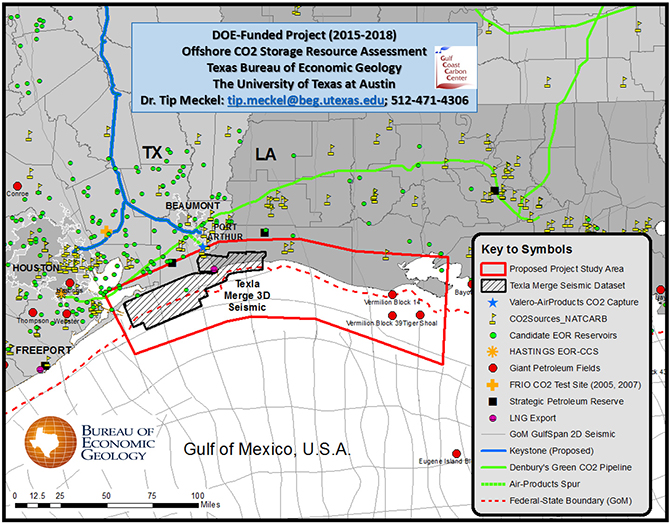
Click map to view larger.
One major milestone of the project was to map the available seismic data in the Project's study area.
This work was published in, DeAngelo, M.V., R. Fifariz, T. A. Meckel, and R. H. Treviño (2019) A seismic-based CO2-sequestration regional assessment of the Miocene section, northern Gulf of Mexico, Texas, and Louisiana, International Journal of Greenhouse Gas Control, vol. 81, pp. 29-37 https://doi.org/10.1016/j.ijggc.2018.12.009
The Project's main dataset comprises the "TXLA 3D seismic survey" whose survey outline is shown by the red polygon. The dataset was leased from SEI, Inc. for the duration of the project.
Another important dataset is the "3D P-Cable Survey" whose survey outline is depicted by the blue rectangle. The P-Cable survey was acquired in 2014 as part of a previous NETL Project, "Gulf of Mexico Miocene CO2 Site Characterization Mega Transect." The P-Cable dataset lies geographically within the TXLA 3D seismic survey, but the former is a high resolution dataset that focuses on the shallowest (approximately) 1 second of the geological section; whereas, the latter, as per industry interest, focuses on the deeper geological section (i.e., where most hydrocarbon resources exist).
Note that the "Additional 3D Seismic Surveys" and the "2D Lines" are publicly available datasets that were obtained from the U.S. Geological Survey (USGS).
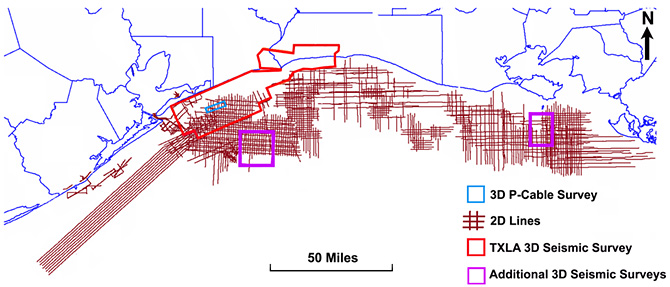
The initial well database for the current project incorporated a pre-existing IHS Petra© database that already contained many dozens of wells with wireline well log data (i.e., rasters and/or LAS - log ASCII standard digital curves) in the study area. There are 11,817 wells in the study area, 5250 of which have wireline well log raster data only (black dots). Of those, 4337 raster logs were purchased from vendor, MJ Systems, Inc. The purchased rasters are for wells in Vermilion and Cameron Parishes, Louisiana and Chambers and Jefferson Counties, Texas. There are 900 wells that have digital SP curves (green dots); 74 have digital gamma ray (red rhombs) and 7 wells have whole core (olive-green squares). The cyan colored dots represent wells currently without raster or LAS data.
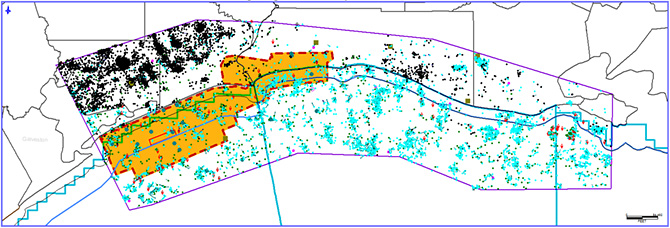
There are a total of 1091 wells within the seismic survey boundaries. Currently, 95 have well log rasters (black dots), but no LAS data. There are 252 wells with digital SP curves (green dots), 22 with digital gamma ray curves (red) and 14 with digital sonic and/or density curves (bluish). The sonic and density data can be used for the important task of time to depth conversion of the seismic dataset.
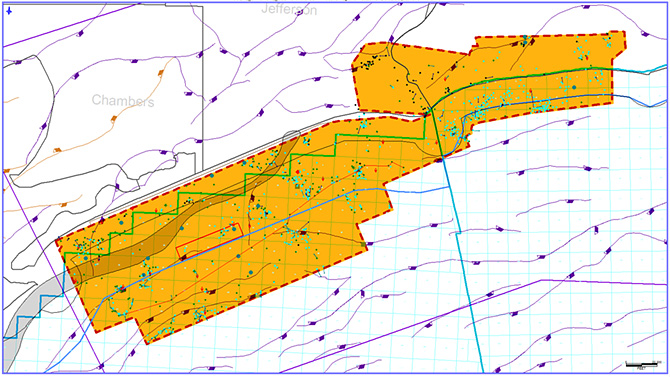
Lines of section for two regional stratigraphic cross sections oriented along depositional strike are indicated by red lines. Normal faults (purple) can be traced over considerable distances along strike (tens of km). The structural strike (NE-SW) is sub-parallel to depositional strike and to the present day

The well data have been used to correlate wells across the study area. The top figure is a regional stratigraphic cross section located in the near-offshore of the upper Texas and westernmost Louisiana coast. (See red line of section in figure above.) The cross section is flattened on the maximum flooding surface associated with biochronozone Amphistegina B (AMPH_B or MFS 9), an important and regionally extensive flooding surface of the region's lower Miocene section.
Similarly, the lower figure is a regional stratigraphic cross section flattened on the Bigenerina A extinction horizon (MFS 1) and upper Miocene flooding surface. (See above for line of section.) Note that the nomenclature of each, respective, cross section is distinct because they result from different historical studies. Consequently, MFS1 is not equivalent to MFS 1 in the two figures below. With availability of more well log data, the intervening central portion of the study area (i.e., between the two regional cross sections) will be correlated to integrate the regional correlations in the two figures.
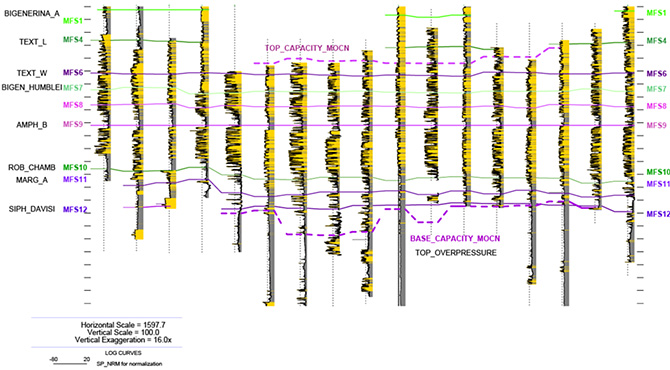
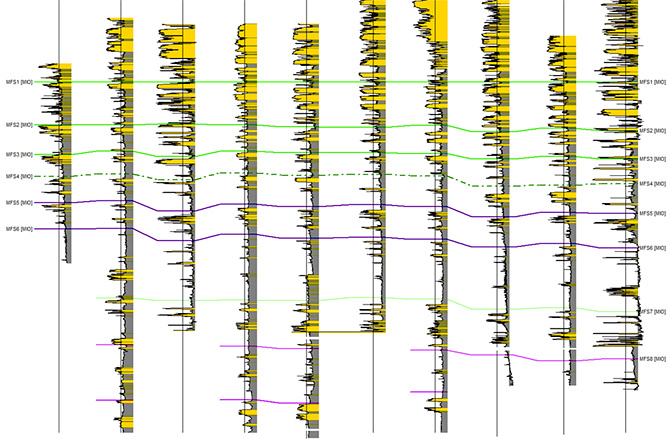
A second major task was to provide an estimate of regional CO2 capacity.
A framework for estimating capacity in the study region was built using seven depth-converted regional seismic horizons. Porosity predictions were developed using multi-attribute analysis with limited log data. A seismic inversion was used to validate porosity volumes. Structural closures were ranked, fetch areas calculated, and stacked opportunities were evaluated for the region.
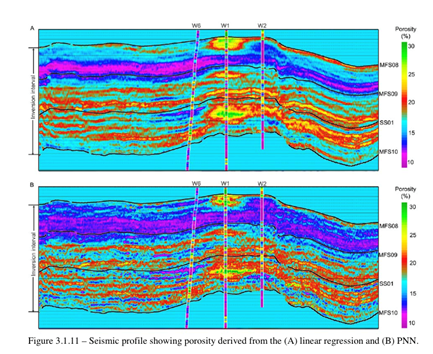
Diffraction imaging, a seismic imaging technique, of a gas chimney identified in a high-resolution 3D dataset improved confidence in the geological properties of the region. This work was published in Klokov, A., Meckel, T. A., & Trevino, R. H. (2018). Confining system integrity assessment by detection of natural gas migration using seismic diffractions. International Journal of Greenhouse Gas Control, 75, 32-40, https://doi.org/10.1016/j.ijggc.2018.05.001 and
Klokov, A., R. H. Treviño, and T. A. Meckel, (2017) Diffraction imaging for seal evaluation using ultra high resolution 3D seismic data, Marine and Petroleum Geology, Volume 82, 2017, Pages 85-96, https://doi.org/10.1016/j.marpetgeo.2017.02.002 and
Merzlikin, Dmitrii, T. A, Meckel, S. Fomel and Y. Sripanich. (2017). Diffraction imaging of high-resolution 3D P-cable data from the Gulf of Mexico using azimuthal plane-wave destruction. First Break. 35. 35-41, http://doi.org/10.3997/1365-2397.2017002
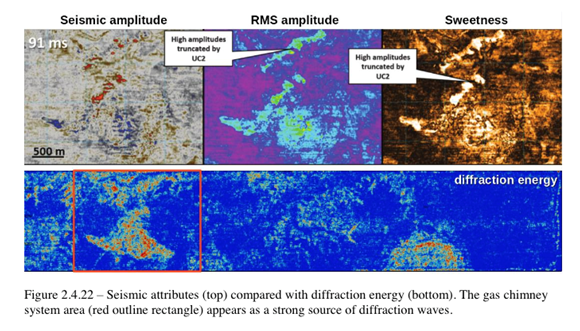
BEG core repositories hold seven cores from the vicinity of the study area. Two were studied in detail. The results revealed good sealing quality. Porosity was about 10% and, importantly, the permeability was low. Mudstone samples were able to retain a CO2 column height of 52 to 309 m.
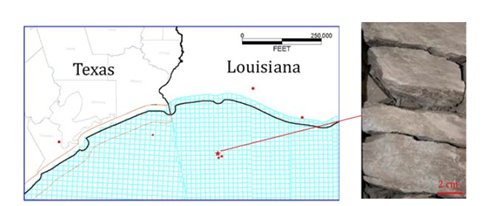

Caption: Example of BEG core from the study region, along with examples of elemental analysis.)
Initial site characterization identified fifteen prospects, which were ranked according to reservoir depth, porosity, lithology, age, depositional environment, structure, presence of a regional seal, and production history as well as the seismic character from the TXLA 3D seismic dataset.
The High Island 10-L and High Island Block 24L fields were chosen for further characterization. Both fields include large rollover, anticline structures, and are stratigraphically below the Amphistegina B regional shale seal.
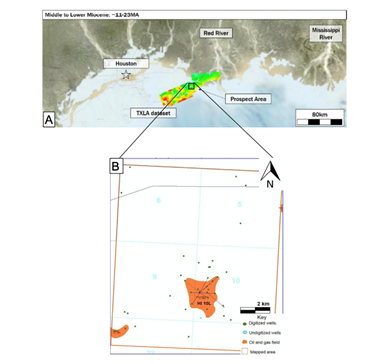
Location of High Island 10-L field within study area.
Characterization of the High Island 10-L field was the subject of Omar Garcia’s Master’s thesis, Geological characterization and modeling of the High Island 10-L field for CO2 storage assessment in Texas State waters, offshore Gulf of Mexico. CO2 capacity estimates ranged from 37 to 40 million metric tons.
The static capacity of the High Island 24L field was estimated to be 7.15 gigatonnes using the methodology of Wallace et al. (2014). Calculating the dynamic storage volume using the 3D porosity model resulted in estimates of 190 million metric tonnes, or using NETL’s CO2-SCREEN tool, 170 million metric tonnes.
Storage estimates at both fields are greater than the project’s 30 million metric tonne objective.
Decline curve analysis of 616 wells was used to determine key production parameters, which were then used to predict cumulative bulk production for each well. Those volumes were converted to CO2 injectable mass equivalents and published in Goudarzi, A., T. A. Meckel, S. A. Hosseini, and R. A. Treviño, (2019) Statistical analysis of historic hydrocarbon production data from Gulf of Mexico oil and gas fields and application to dynamic capacity assessment in CO2 storage, International Journal of Greenhouse Gas Control, Vol. 80, pp. 96-102 https://doi.org/10.1016/j.ijggc.2018.11.014
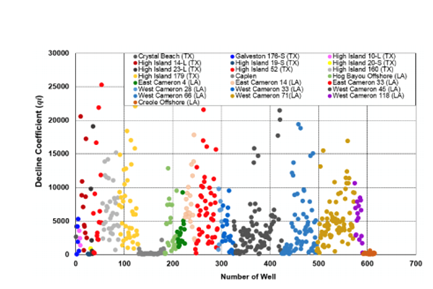
Plot of decline rate distribution for wells from 21 analyzed gas fields.
The final step in this project was to evaluate likely prospects using the dynamic CO2 capacity assessment, EASiTool. Results indicated that the analyzed fields have storage capacity of up to 197 million metric tones.
Summary of Project Successes
DeAngelo, M.V., Fifariz, R., Meckel, T., and Treviño, R.H., 2019, A Seismic-Based CO2-Sequestration Regional Assessment of the Miocene Section, Northern Gulf of Mexico, Texas and Louisiana. International Journal of Greenhouse Gas Control, v. 81, p. 29–37. https://doi.org/10.1016/j.ijggc.2018.12.009.
Olariu, M.I., DeAngelo, M., Dunlap, D., and Treviño, R.H., 2019, High Frequency (4th Order) Sequence Stratigraphy of Early Miocene Deltaic Shorelines, Offshore Texas and Louisiana. Marine and Petroleum Geology v. 110, p. 575–586. https://doi.org/10.1016/j.marpetgeo.2019.07.040.
Last Updated: March 31, 2025



